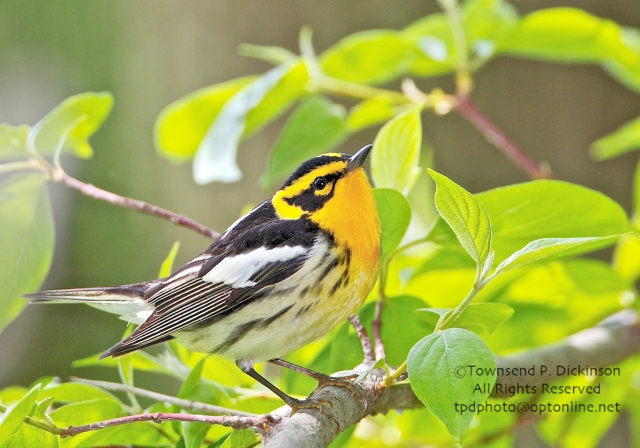
Blackburnian Warbler (Dendroica fusca) male, spring migrant, foraging in forest along Lake Erie, viewed from boardwalk at Magee Marsh Wildlife Area, Oak Harbor, Ohio. ©Townsend P. Dickinson. All Rights Reserved.
We saw a male Blackburnian Warbler today at Birdcraft Sanctuary in Fairfield, CT, he was moving fast and foraging high. We saw many a year ago in Ohio at Magee Marsh, but the trees are lower and they were foraging at eye level and that migrant trap had a bigger pull. It was a nice modest fall out day and we saw other migrants as well. It was nice to see them again and we were elated to welcome them back. I shudder to think of all that this survivor has to face to afford us this fleeting look and yet my first stupid though is it sure is a pretty bird and I’m glad I saw it.
He likely spent the winter months, December through February in the lower Isthmus of Panama or Northern South America foraging as an integral part of the montane forest avifauna. Since he is likely more than two years old, he probably spent the previous winter within a ¼ of a mile this years wintering territory.
He headed north in March and likely followed the Central American land corridor up to the Yucatan in Mexico dodging predators along the way. He either jumped the Gulf of Mexico or hopscotched up the Caribbean and Florida Peninsula in April in a loose flock of his own kind on favorable winds. He was likely not alone, but shared the night sky with tens and tens of thousands of other birds. Forty years earlier he would have had more company, well over half of the trans gulf migrants have been lost by various causes since the 1960’s based on data gathered by Sid Gauthreaux, Clemson. They hit the gulf coast status in late March.
Once safely over the Gulf, the narrow stream of fellow migrants broadens out to fill the eastern half of the continent. By mid May they have reached birding hot spots such as Crane Creek, Ohio; Birdcraft Sanctuary, Connecticut; Central Park, NY or Monhegan Island, Maine. They still have a ways to go before they hit their breeding grounds in the boreal forests stretching from the Canadian Maritimes to Saskatchewan and in the Eastern Mountains of the US.
They raise their families in nests in conifer trees within the mature coniferous and mixed coniferous/deciduous forests and feast on the flush of spring insects and invertebrates. In fact without the foraging songbirds, the forest would be overrun with micro herbivores. When the young birds fledge they may join foraging flocks of chickadees, kinglets and nuthatches and continue the harvest during the warm months.
Fall migration can begin as early as late July and by August a stream of migrating warblers is reversing it’s spring journey back to the wintering grounds.
Here’s the rough math. Two months up, two months breeding, two months back down, and 6 months wintering, I am sure glad they are our birds. All they have to do is not get eaten by birds, snakes or mammals, not get poisoned, not get stuck in oil, not hit a window, not hit a building or a windmill or a radio tower, not get disorientated by city lights, find places to forage in forests every day of the long journey up and back, avoid ten million domestic cats everywhere along the route, wind storms and freezing temperatures.








I have just e-mailed a response to you praising you for this wonderful, well written article!
Thank you Walt for your wonderful and kind words. I did get this and your email and responded.
Please keep coming back to visit.
enjoyed your Blackburnian Warbler blog